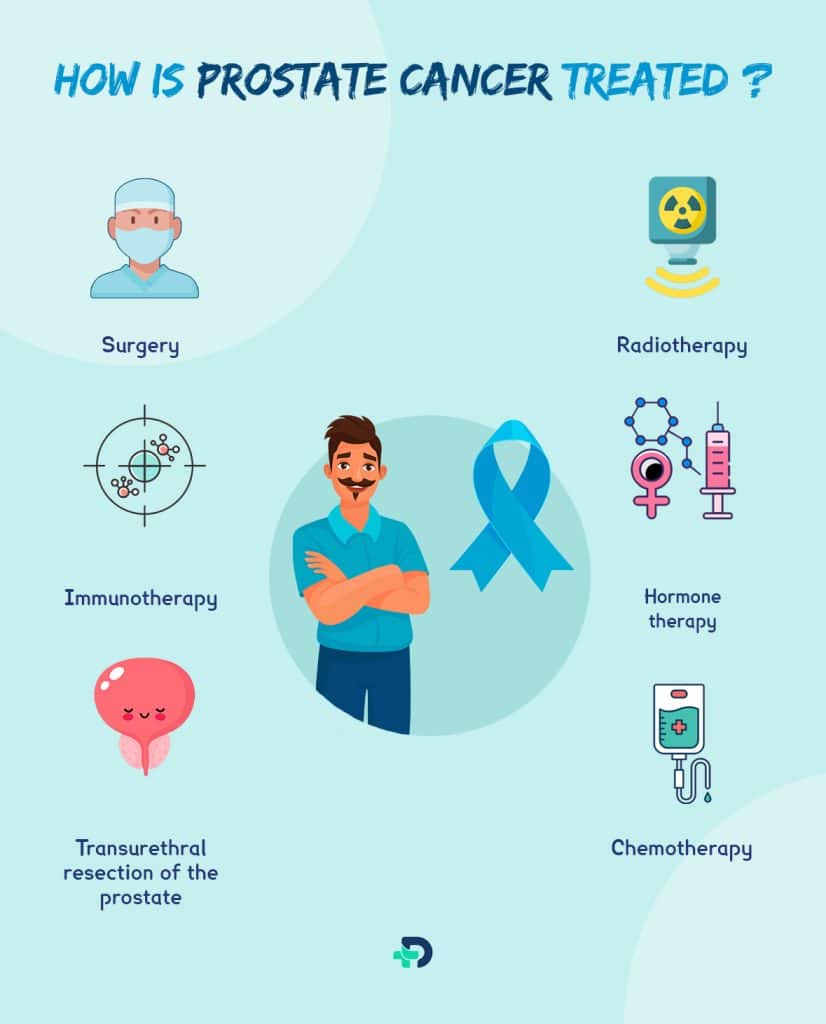Prostate Cancer: Understanding Symptoms, Types, Treatment and Prognosis

- Prostate Cancer
- 22 Aug 2023
Overview
About Prostate cancer
The term “prostate cancer” is used when cancer first manifests itself in the prostate gland. The prostate is a tiny, rubbery gland in men situated deep within the groin, between the base of the penis and the rectum which is essential for reproduction. It provides a portion of the seminal fluid (semen), which combines with sperm from the testicles to aid in sperm’s motility during fertilization. [1]
Who is predisposed (inclined) to Prostate Cancer?
Every man is at risk of prostate cancer. Growing older is the main risk factor. A man’s risk of developing prostate cancer increases with age. A family history of prostate cancer raises a man’s risk of getting the disease in some cases.1Overview| Researched based study from Cdc.gov

Symptoms
What signs and symptoms indicate Prostate cancer?
Some common symptoms are:
- A weak urine flow
- Frequent urination (especially at night)
- Inability to completely empty the bladder
- Interrupted flow of urine.2Symptoms| Researched based study from Cdc.gov
When to seek medical help?
If you experience any of the following signs, see a doctor straight away:
- Having difficulty urinating
- When urinating, there is a pain/burning sensation
- Blood in the sperm or urine
- Persistent pelvic, hip/back discomfort
- Unpleasant ejaculation1Symptoms| Researched based study from Cdc.gov
Diagnosis
Diagnostic tests for Prostate cancer
The following are some of the tests and techniques used to diagnose prostate cancer:
Health history and physical examination
- This test comprises a physical examination of the patient’s body to look for any lumps or other abnormalities that might indicate a disease or general symptoms of health.
- A detailed health history includes gathering information on the patient’s health habits and past illnesses which aid in the diagnosis of the condition.
Digital rectal examination
- In this examination, a gloved, lubricated finger is inserted into the rectum by the doctor/nurse to feel for enlargement, soreness, lumps, or hard spots on the prostate gland which may aid in the diagnosis of the condition.
PSA (prostate-specific antigen) test
- The PSA test, which is frequently performed in conjunction with a digital rectal examination, is the most popular prostate cancer screening tool that aids in the early detection of the disease.
PSMA-PET (Prostate-specific membrane antigen – Positron emission tomography) scan
- The PSMA-PET scan is an imaging procedure used to find prostate cancer anywhere in the body.
- It employs a radioactive material that seeks out a protein known as prostate-specific membrane antigen (PSMA) in the body which is generally expressed high in patients affected with prostate cancer.
Transrectal ultrasound (TRUS)
- Sound waves are used to produce a visual image of the prostate gland during this 5- to 15-minute outpatient procedure.
- In the rectum, a small, lubricated probe is inserted, causing sound waves to be emitted which pass through the prostate, producing echoes. The echoes are then relayed back to a computer, which converts the pattern into a picture of the prostate, indicating the presence of a tumor.2Diagnosis| Researched based study from Cancer.gov
Stages
What is Prostate cancer staging?
The cancer’s location, whether or not it has spread or impacting other body regions are all described under the term called “cancer staging.”
In order to determine whether the disease has progressed from the prostate to other parts of the body, test results are examined as a part of the staging process for prostate cancer. The stage can be used to anticipate a patient’s prognosis, or the likelihood of recovery, and help the doctor to select the best treatment plan for the condition.
There are two staging possibilities for prostate cancer:
- Clinical staging
- Pathologic staging
Clinical staging
- On the findings of a digital rectal exam, prostate-specific antigen (PSA) test, and Gleason score, clinical staging is concluded. The results of this test will help in evaluating whether other imaging techniques, such as X-rays, CT, or MRI scans, are necessary for clinically staging the condition.
Pathologic staging
- This is based on information found during surgery as well as the laboratory findings of prostate tissue extracted during surgery, which frequently entails the removal of the complete prostate gland along with lymph nodes.
Gleason score
- Based on how much cancer resembles healthy tissue when examined under a microscope, prostate cancer is given a grade known as a Gleason score.
- The Gleason scoring system is the one that is most frequently used to assess prostate cancer.2Stages| Researched based study from Cancer.gov
Types
Types of Prostate Cancer
The most common form of prostate cancer is adenocarcinoma, which arises in the glandular epithelial cells that line the core of the prostate gland.
It has two subtypes namely:
- Acinar adenocarcinoma
- Prostatic ductal adenocarcinoma
Acinar adenocarcinoma
- It is the commonest form of adenocarcinoma which may be felt by the doctor during digital rectal examination. It is generally associated with increased PSA levels in the blood.
Prostatic ductal adenocarcinoma
- This is an uncommon but aggressive type of adenocarcinoma that doesn’t always cause an increase in PSA levels in the blood, making it more difficult to detect on time resulting in its delayed management.3Types| Researched based study from Cancercenter.com
Treatment

How is prostate cancer treated?
Prostate cancer can be treated with a variety of methods, some of which are listed below:
Active surveillance/watchful waiting
- When prostate cancer is found through screening tests or in individuals who are older men (without symptoms), watchful waiting and active monitoring are the recommended treatments.
- When a patient’s condition is being attentively watched, no therapy is given until new or different indications or symptoms develop. Active surveillance is monitoring a patient’s status carefully without intervening with treatment unless test findings change.
Surgery
Surgical treatment is indicated only in those patients in whom the tumor has not metastasized and is confined only to the prostate gland.
The following are some surgical procedures:
- Radical prostatectomy (prostate removal)
- PLND (Pelvic lymphadenectomy)
- TURP (Transurethral resection of the prostate)
Radical prostatectomy
- It is a type of surgical procedure done to remove the prostate, surrounding tissue, and seminal vesicles (with or without neighboring lymph nodes) followed by a prostate cancer diagnosis.
PLND/Pelvic lymphadenectomy
- Is a form of surgery used to remove the pelvic lymph nodes. The excised tissue is examined under a microscope by a pathologist to look for malignant cells. If it is determined that the lymph nodes are malignant, the doctor might advise trying alternate therapies rather than removing the prostate.
TURP/Transurethral resection of the prostate
- Is a kind of surgery that includes passing a resectoscope via the urethra to cut off prostate tissue. A resectoscope is a small, lighted tube that has a cutting instrument within it. This procedure is used to treat benign prostatic hypertrophy and sporadically to alleviate tumor-related symptoms before the start of additional cancer treatments.
Radiotherapy
- Radiotherapy, a type of cancer treatment, uses high-energy radiation, such as X-rays or other types of radiation, to kill or stop the growth of cancer cells.
Hormone therapy
- By eliminating hormones or inhibiting their activity, hormone therapy is a type of cancer treatment that stops the proliferation of cancer cells. Male sex hormones can promote the growth of prostate cancer which can be blocked by androgen deprivation therapy, a type of hormone therapy that lowers or blocks the production of male hormones through medication, surgery, and/or the use of other hormones.
Chemotherapy
- Chemotherapy is a sort of cancer treatment that uses medications to either destroy cancer cells or prevent them from spreading to different parts of the body.
Targeted therapy
- With the use of medication or other substances, targeted therapy is a sort of cancer treatment that locates and eliminates specific cancer cells. The effects of targeted therapy on healthy cells are less severe than those of chemotherapy or radiation treatment.
Immunotherapy
- Immunotherapy is a cancer therapy that assists the immune system to fight cancer. It’s a form of biological therapy that combats cancer by using drugs derived from living organisms. 2Treatment| Researched based study from Cancer.gov
How to prevent prostate cancer?
- Prostate cancer cannot be prevented in an efficient way. However, making healthy decisions like exercising and/or eating a balanced diet can lower the risk of developing prostate cancer.4Prevention| Researched based study from Mayoclinic.org
Prognosis
Prognosis of Prostate cancer
Prostate cancer often has a good prognosis, particularly if it is found early.
Survival as per stages of Prostate cancer:
Stage-1
- Stage 1-Prostate cancer that has expanded to less than half of one side of the prostate is considered to be in stage 1. Most patients in Stage 1, remain cancer-free for at least five years after being diagnosed with the disease.
Stage-2
- Stage 2-Patients with stage 2 prostate cancer have more than half of one side of the prostate gland impacted. Nearly everyone in Stage 2, will remain cancer-free for at least five years after being diagnosed
Stage-3
- Stage 3-In Stage 3, the cancer penetrates into the prostate gland’s covering and spreads to the tubes that transport semen. About 95% of people who are diagnosed with cancer will continue to be cancer-free for at least five years.
Stage-4
Stage 4-Stage 4 can refer to a variety of things, such as:
- The bladder or back channel is among the neighboring body organs where the malignancy has spread.
- Surrounding lymph nodes have become infected with malignancy.
- The cancer has migrated outside of the pelvis to the lungs or liver, among other body areas.
In this stage, 50% of males will remain cancer-free for at least five years after being diagnosed with the condition.5Prognosis| Researched based study from Cancerreserchuk.org
Takeaway
Takeaway tips
- The most frequently discovered malignancy and the sixth most prevalent cause of cancer death in males is prostate cancer.
- Prostate cancer is a disease that could affect any male. Age is the most frequent risk element.
- Seek medical help immediately when you experience symptoms such as difficult urination, pain/burning sensation (while urinating), blood in the sperm/ urine, and/or persistent pelvic, hip pain, or back discomfort
- Prostate-specific cancer is regarded as a localized and potentially treatable disease when it is confined only to the prostate.
- Prostate cancer cannot be prevented in any way that is reliable. However, one can reduce their risk of getting prostate cancer by adopting healthy choices like exercising and eating a balanced diet.
- Prostate cancer often has a good prognosis, particularly if it is found early.6Takeaway| Researched based study from Nlm.nih.gov
Any feedback on this article?
 This Articles content was accurate
This Articles content was accurate Very Informative Article
Very Informative Article I have a question or a comment
I have a question or a comment
 This article contains inaccurate content
This article contains inaccurate content This article was not helpful
This article was not helpful I have a question or a comment
I have a question or a comment
We appreciate your helpful feedback!
Checkout our social pages
References
-
Centers for Disease Control and Prevention
Prostate Cancer | Overview | Symptoms
-
National Cancer Institute
Prostate Cancer | Symptoms | Diagnosis | Treatment | Stages
-
City Of Hope
Prostate Cancer | Types
-
Mayo Clinic
Prostate Cancer | Prevention
-
CancerResearch UK
Prostate Cancer | Prognosis
-
National Library of Medicine
Prostate Cancer | Takeaway




































